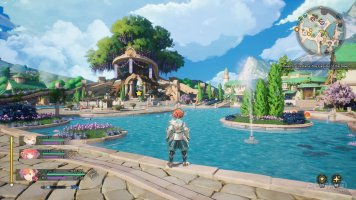General Information
Visions is essentially a retread of old ideas, just brought forward into a vast 3D world. It's built to be nostalgic — a colourful reminder of what made the original Mana games so magical. It tries to recapture the sense of adventure that seemed so powerful back in the 90s — when it was just a collection of pretty sprites on a pixelated screen. And to a surprisingly large extent, Visions succeeds. It is nostalgic and it does conjure those same feelings that classic RPGs have now thrived upon for decades.
But the pursuit of nostalgia can be a double-edged sword. In running so parallel to its predecessors, Visions occasionally comes across as dated, stiff, and — most damningly — boring. In particular, its storytelling is both predictable and bloated. The plot buckles under a painfully bland cast of main characters, all of whom have a terrible habit of repeating their cookie-cutter motivations at every opportunity.
It's a misstep that drags the game's pacing down far too often. In classic RPGs, dialogue is typically kept to a minimum — the visual-novelisation of the genre hadn't yet taken hold, and characters were given just a few lines to get their point across, peppering the broader journey with flickers of additional drama or humour. Your party members in Visions are cut from the same cloth — they're supposed to be charmingly simplistic — but they're handed one hundred times the amount of dialogue.
Visions adopts an episodic approach to its overall narrative, setting up the next story beat whenever you reach a new town or city. It introduces key players and the problem at hand, and then your party usually takes some time to talk it all through. The problem, though, is that these sequences involve a lot of tedious trekking between objective markers, only to hear your allies repeat the same basic notions, over and over. Visions wants to set the stage with meaningful character interactions, but the writing quality and necessary character depth simply never manifest.
Thankfully, Visions is a much more compelling experience away from its mostly vapid storytelling. That sense of adventure we mentioned earlier is alive and well when you're between towns, exploring the game's huge and varied environments. This is the one area where the title looks to set itself apart from what's come before, taking inspiration from modern open worlds. While these locations aren't completely open — they're stitched together as MMO-like zones — they're big, and reasonably interesting to traverse.
They also look fantastic. The game does an impressive job of portraying the scale of its world; stylised landmarks like mountains and old castles can be glimpsed off in the distance, long before you actually get to them. Visions may not be a graphical powerhouse, but the artistry on display — especially in an environmental sense — is often exemplary.
Having said all of that, scale does come back to bite the release the every now and then. The game's largest locations can feel empty from a gameplay perspective, as if you're plodding miles between anything of worth. Granted, the vistas can sometimes make up for the lack of action, but most players will quickly fall back on fast travel whenever the title demands a bit of backtracking.
Together with exploration, combat will make up for much of your playtime. Battles are fun hack-and-slash affairs that aren't too flashy or overly challenging. You control your chosen character, while the AI takes charge of up to two allies. The system itself is a modernization of Mana's longstanding formula — a mixture of simple combos, dodge rolls, and special moves. Here, combat's been given a little more weight; it's a touch more deliberate. Attacks have a nice heft to them, and your evasion has to be pretty on-point. Again, beyond a handful of tricky boss encounters it's fairly forgiving, but the underlying ebb and flow of battle falls more in line with modern action RPGs.
Boss fights are where the combat really shines. They're not going to blow you away in terms of sheer spectacle, but they know how to provide satisfying — and sometimes entirely unique — mechanics, which helps them stand out. Teamwork, too, is emphasized during these bouts, as you can switch between characters and exploit elemental weaknesses, or make use of character-specific healing abilities.
Our only quibble lies with the AI that drives your companions. Most of the time, your allies are more than capable of holding their own, but against certain bosses, they simply don't know how to deal with specific mechanics, and will fail to avoid devastating attacks or environmental hazards. These moments of frustration are thankfully few and far between — and they can be mitigated to some degree by customizing the AI's behavior — but they're still an undeniable low point for a combat model that's otherwise systematically sound and enjoyable.
What's more, battles are supplemented by classes — elemental archetypes that can be applied to all of the playable cast. Classes are unlocked as the story progresses, and each character has nine potential roles: a starting class, and eight elemental-based evolutions. There are numerous weapon types and abilities to tinker with, and every class even has its own distinct visual design. It's a great little system to play around with, since you can switch classes at any time through the menu, and coming up with your own party compositions is a genuine highlight.
Classes grant combat a level of experimental depth that just wouldn't be there otherwise. Depending on the character and assigned weapon type, each class has its own set of moves and skills, alongside passive perks that solidify its intended role in the party. Classes are clearly a mechanical focal point, and Visions does an admirable job of implementing them.
Conclusion
As a nostalgia-driven retread of the classic Mana adventure, Visions of Mana is rock solid — but it struggles to be anything more than a reminder of how magical those old RPGs could be. If you can look beyond the game's monotonous storytelling and tragically bland characters, the essence of an old-school excursion is here, in the exploration of wonderful environments and in battles against burly boss monsters.





